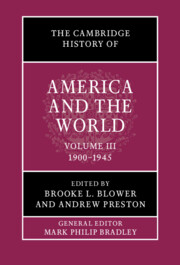Book contents
- The Cambridge History of America and the World
- The Cambridge History of America and the World
- The Cambridge History of America and the World
- Copyright page
- Contents
- Figures
- Maps
- Contributors to Volume III
- General Introduction: What is America and the World?
- Introduction to Volume III
- Part I American Power in the Modern Era
- 1 The Sinews of Globalization
- 2 The Territorial Empire
- 3 Waging World War I
- 4 Technological Transformations
- 5 Law and American Power
- 6 Latin America and US Global Governance
- 7 Transatlantic Relations
- 8 The Open Door, Tsarist Russia, and the Soviet Union
- 9 The Rise of the Modern Middle East
- 10 Competing Empires in Asia
- 11 Making a Modern Military
- Part II Competing Perspectives
- Part III The Perils of Interdependence
- Index
1 - The Sinews of Globalization
from Part I - American Power in the Modern Era
Published online by Cambridge University Press: 12 November 2021
- The Cambridge History of America and the World
- The Cambridge History of America and the World
- The Cambridge History of America and the World
- Copyright page
- Contents
- Figures
- Maps
- Contributors to Volume III
- General Introduction: What is America and the World?
- Introduction to Volume III
- Part I American Power in the Modern Era
- 1 The Sinews of Globalization
- 2 The Territorial Empire
- 3 Waging World War I
- 4 Technological Transformations
- 5 Law and American Power
- 6 Latin America and US Global Governance
- 7 Transatlantic Relations
- 8 The Open Door, Tsarist Russia, and the Soviet Union
- 9 The Rise of the Modern Middle East
- 10 Competing Empires in Asia
- 11 Making a Modern Military
- Part II Competing Perspectives
- Part III The Perils of Interdependence
- Index
Summary
Reports of the United States’ rise to a lead role on the global stage in the early twentieth century have been greatly exaggerated. As many Americans at the time recognized, the United States continued to have less capacity for overseas power projection and remained far more dependent on the world’s reigning hegemon, Great Britain, than is generally now realized. The United States, it is true, acquired an overseas empire in 1898. But it lacked basic attributes of economic sovereignty, naval power, and domestic consensus on the desirability of global great-power status. Even after World War I, a better candidate than the Spanish-American War as the moment when the United States became a leading global power, both the material and the cultural basis of that power remained fragile.
- Type
- Chapter
- Information
- The Cambridge History of America and the World , pp. 37 - 61Publisher: Cambridge University PressPrint publication year: 2022



